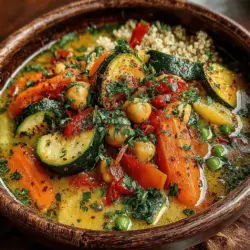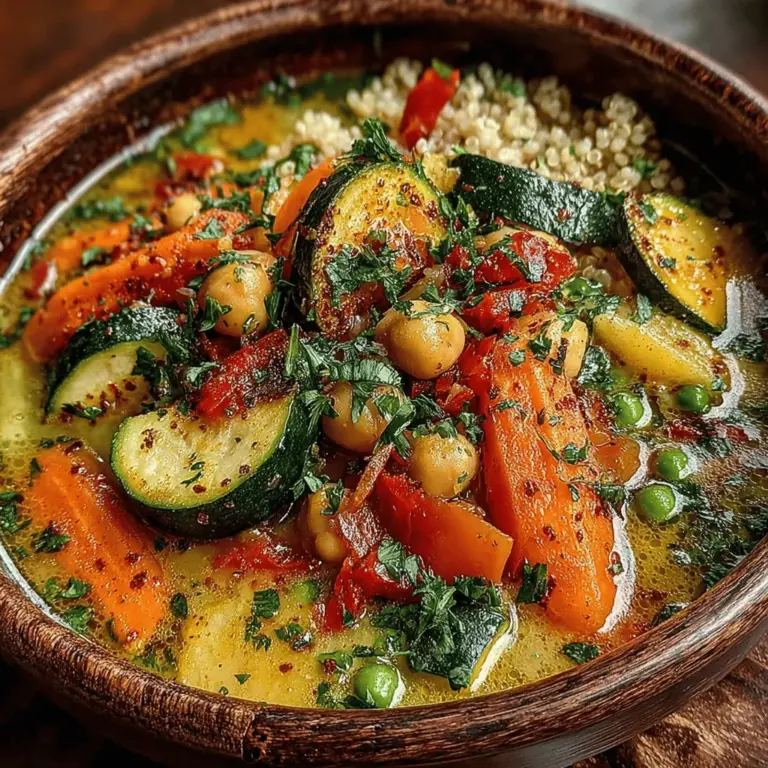Introduction: Discover the Comfort of Cozy Chickpea Vegetable Curry
In a world where meals often need to be quick and convenient, finding a recipe that is both nourishing and full of flavor can be a challenge. Enter the Cozy Chickpea Vegetable Curry—an inviting dish that is perfect for any occasion. This hearty curry combines protein-packed chickpeas with a medley of colorful vegetables, all simmered in rich coconut milk and aromatic spices. Whether you’re a seasoned cook or a kitchen novice, this recipe is designed to guide you through each step, ensuring a delightful cooking experience and a meal that warms both body and soul.
Ingredients
– 1 can (15 oz) chickpeas, drained and rinsed
– 1 can (14 oz) coconut milk
– 1 medium onion, diced
– 3 cloves garlic, minced
– 1 tablespoon fresh ginger, grated
– 2 carrots, sliced
– 1 bell pepper, diced
– 1 zucchini, chopped
– 1 cup frozen peas
– 2 tablespoons curry powder
– 1 teaspoon ground cumin
– 1 teaspoon ground turmeric
– 1/4 teaspoon cayenne pepper (optional)
– Salt and pepper to taste
– 2 tablespoons olive oil
– Fresh cilantro for garnish (optional)
Instructions
1. Heat the olive oil in a large skillet over medium heat.
2. Add the diced onion, and sauté until translucent, about 5 minutes.
3. Stir in the minced garlic and grated ginger, cooking for an additional 1-2 minutes until fragrant.
4. Add the sliced carrots and bell pepper to the skillet, and cook for about 3-4 minutes, stirring occasionally.
5. Incorporate the chopped zucchini and frozen peas, mixing well with the other vegetables.
6. Sprinkle in the curry powder, ground cumin, ground turmeric, and cayenne pepper, if using. Stir to coat the vegetables evenly with the spices.
7. Pour in the coconut milk and add the drained chickpeas. Stir to combine all ingredients.
8. Season with salt and pepper to taste, and bring the mixture to a simmer.
9. Reduce the heat to low, cover, and let it cook for 15-20 minutes, stirring occasionally, until the vegetables are tender.
10. Serve hot, garnished with fresh cilantro if desired.
Understanding the Key Ingredients
Exploring the Components of Chickpea Vegetable Curry
The Nutritional Power of Chickpeas
Chickpeas, also known as garbanzo beans, are a fantastic source of plant-based protein and fiber. They provide essential nutrients that can help support digestion and maintain steady energy levels.
The Creaminess of Coconut Milk
Coconut milk adds a rich, creamy texture to the curry, enhancing its overall flavor. This dairy-free option is perfect for those with lactose intolerance and complements the spices beautifully.
The Aromatic Trio: Onion, Garlic, and Ginger
This trio forms the flavor foundation of the curry. Onions provide sweetness, while garlic and ginger add depth and warmth, creating a robust base for the dish.
Color and Flavor from Fresh Vegetables
Incorporating a variety of colorful vegetables not only makes the dish visually appealing but also boosts its nutritional profile. Each vegetable brings its unique flavor and texture, making every bite delicious.
The Role of Spices in Enhancing Taste
Spices are the heart of any curry. They not only elevate the flavor but also offer health benefits. The combination of curry powder, cumin, turmeric, and cayenne creates a harmonious balance that is both aromatic and invigorating.
Preparation Steps for a Flavorful Base
Sautéing Aromatics for Maximum Flavor
Choosing the Right Cookware: Skillet vs. Crockpot
Selecting the proper cookware can significantly influence the outcome of your dish. A large skillet allows for better sautéing, while a crockpot can be a convenient option for slow cooking.
The Importance of Sautéing Onions, Garlic, and Ginger
Sautéing these aromatics helps to unlock their flavors, making the base of your curry rich and fragrant. It’s an essential step that shouldn’t be rushed.
Tips for Achieving the Perfect Aroma
Keep an eye on the heat level to prevent burning, and stir frequently. Adding a pinch of salt can help draw out moisture from the vegetables, intensifying their flavors.
Creating the Curry Blend
Incorporating Vegetables and Seasonings
Selecting Seasonal Vegetables: Carrots, Bell Peppers, Zucchini, and Peas
Choosing seasonal vegetables not only enhances the flavor but also ensures you’re using the freshest ingredients available. This can elevate your curry to a whole new level.
Mixing Spices: Building Flavor Profiles with Curry Powder, Cumin, Turmeric, and Cayenne
Each spice contributes to the overall flavor complexity of the dish. Adjust the quantities according to your taste preferences for a milder or spicier curry.
Balancing Flavors: The Role of Salt and Pepper
Salt and pepper are crucial in balancing the flavors of the curry. Taste frequently and adjust as necessary to ensure a well-rounded dish.
Cooking Methods: Slow Cooker vs. Traditional Stovetop
When it comes to preparing your Cozy Chickpea Vegetable Curry, you can choose between a slow cooker for a hands-off approach or the traditional stovetop for quicker results. Each method has its advantages, allowing you to enjoy this comforting dish in a way that best suits your schedule.

Comparing Cooking Techniques for Optimal Results
Benefits of Using a Slow Cooker for Curry
Using a slow cooker for your Cozy Chickpea Vegetable Curry allows for deep flavor development as the ingredients meld together over time. The slow cooking process tenderizes the vegetables and enhances the taste of spices, resulting in a rich and satisfying dish. Furthermore, it’s an excellent option for busy individuals, enabling you to prepare your meal in advance and let it cook while you attend to other tasks.
How to Adjust Cooking Times for Different Methods
When using a slow cooker, plan for at least 4 to 6 hours on low or 2 to 3 hours on high. If you are using a stovetop, aim for about 30 to 40 minutes of simmering. For pressure cooking, 10 to 15 minutes under pressure will yield a similar result. Always consider the cooking method you’re using and adjust your timing accordingly to ensure the chickpeas and vegetables are perfectly cooked.
Tips for Stirring and Monitoring Cooking Progress
While cooking, it’s essential to stir occasionally, especially if using a stovetop or slow cooker, to prevent sticking. Monitoring the consistency is also critical; if the curry appears too thick, consider adding a splash of vegetable broth or coconut milk. For slow cookers, avoid opening the lid too often, as this can interrupt the cooking process and extend cooking time.
Final Touches: Adjusting Consistency and Flavor
Perfecting the Curry Before Serving
Before serving your curry, it’s crucial to taste and adjust the seasonings. A dash of salt, a squeeze of lime, or an added pinch of spice can elevate the dish. If you find the flavors lacking, don’t hesitate to enhance it with additional spices or herbs.
Thickening or Thinning the Curry: When to Add Liquid
If your curry is too thick, add a small amount of water or coconut milk gradually until you reach your desired consistency. Conversely, if it’s too thin, allow it to simmer uncovered for a few more minutes to reduce the liquid.
Garnishing with Fresh Cilantro: Enhancing Visual Appeal
Garnishing your curry with fresh cilantro not only adds a pop of color but also enhances its flavor profile. The freshness of cilantro balances the richness of the curry, making it more inviting and appealing.
Serving Suggestions for a Complete Meal
Pairing Your Curry with Delicious Sides
A Cozy Chickpea Vegetable Curry pairs excellently with various sides that complement its flavors and textures.
The Best Options: Rice vs. Quinoa
Traditionally, curry is often served with white or brown rice, which absorbs the sauce beautifully. However, quinoa is a nutritious alternative that adds a nutty flavor and extra protein, making it a fantastic choice for a wholesome meal.
Exploring Flavor Pairings: What to Serve with Your Curry
Consider serving your curry with naan bread for dipping or a fresh side salad to add crunch and freshness. Additionally, yogurt or raita can help balance the spices and add creaminess to your meal.
Creative Serving Ideas: Bowls, Platters, and More
For a visually stunning presentation, serve your curry in bowls topped with cilantro and a dollop of yogurt. Alternatively, create a platter with rice or quinoa and arrange the curry alongside colorful vegetables for a family-style meal.
Nutritional Information and Benefits of the Dish
Understanding the Health Aspects of Cozy Chickpea Vegetable Curry
This dish is not only delicious but also packed with nutrients.
Caloric Breakdown and Nutritional Content
A serving of Cozy Chickpea Vegetable Curry typically contains around 300-400 calories, depending on the portion size and specific ingredients used. It provides a good balance of carbohydrates, protein, and healthy fats.
Health Benefits of Ingredients: From Chickpeas to Coconut Milk
Chickpeas are an excellent source of plant-based protein and fiber, promoting digestive health and satiety. Coconut milk adds creaminess while providing healthy fats that are beneficial for heart health. The variety of vegetables included also boosts the nutrient profile significantly.
How This Dish Fits into a Balanced Diet
Incorporating this curry into your meal plan can contribute to a balanced diet filled with essential vitamins and minerals. It’s a versatile dish that can be adjusted to fit various dietary needs, making it suitable for vegetarians, vegans, and those seeking gluten-free options.
Conclusion: Embracing the Comfort of Home-Cooked Meals
This Cozy Chickpea Vegetable Curry not only nourishes the body but also offers an experience of comfort and satisfaction, making it a perfect choice for family gatherings, weeknight dinners, or meal prep for busy days ahead. With its simplicity and wholesome ingredients, this curry is sure to become a cherished addition to your culinary repertoire, inviting you to embrace the joy of home-cooked meals.

